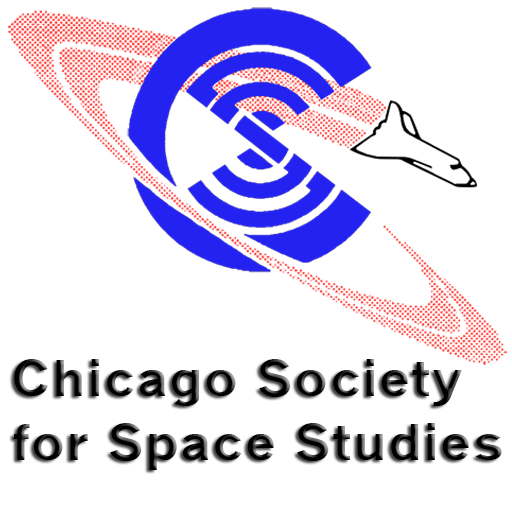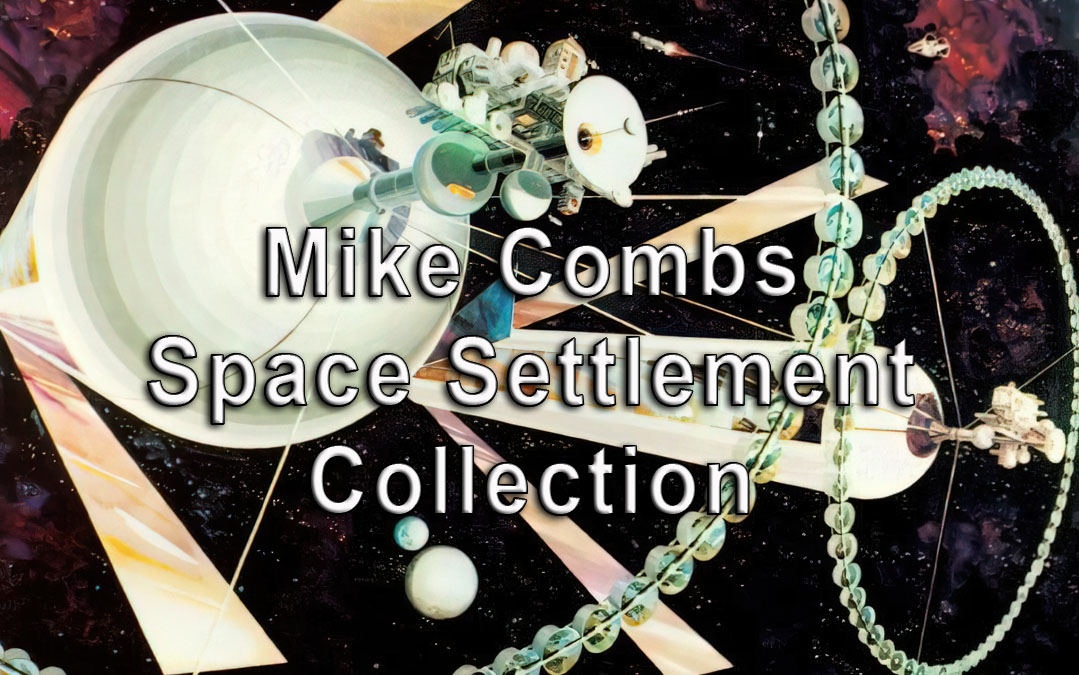Mike Combs Space Settlement Collection: The Chicago Society for Space Studies is offering this collection of space settlement articles and space settlement short stories through the courtesy of Mike Combs, the creator and author of The Space Settlement Website, which he maintained from 1996 to 2014. An archived version of that original website was subsequently maintained by the National Space Society through 2023. This new version of the website has been updated to be mobile-friendly and fully integrated into the Chicago Society for Space Studies website. According to Mike, the purpose of his website is to keep the vision of Gerard O’Neill fresh in the minds of space advocates. Our thanks to Mike Combs for his permission to host and reformat his original website and content.
Space settlement is a unique concept for colonization beyond the Earth. While most thinking regarding the expansion of the human race outward into space has focused on the colonization of the surfaces of other planets, the space settlement concept suggests that planetary surfaces may not be the best location for extraterrestrial colonies. Artificial, closed-ecology habitats in free orbit would seem to have many advantages over any planetary home (Earth included).
While here, take a stroll through the Space Settlement Art Gallery. These computer animations show what life might be like in large space habitats.
For more information about space settlement, read the Space Settlement FAQ (Frequently Asked Questions)
Space Settlement Articles
Following are a series of articles that I have written on the topic of space settlement.
The Advantages of Space Living Over Planetary Living started out as a paper written for a college seminar hosted by Gerard O’Neill. It was later re-written for publication in a Star Trek fanzine.
Optimal Solar System Locations for Orbital Habitats: One of the most outstanding advantages orbital habitats have over planetary colonies is while the latter would be settlements in one particular location, space habitats can be built anywhere in the solar system we want to be. While O’Neill-type habitats can orbit almost anywhere, it’s still the case that some orbits would be more advantageous than others. Where is the prime orbital real estate in our solar system? Learn in Optimal Solar System Locations for Orbital Habitats.
In Crossroads, there is a comparison between two different futures: One with space travel, and the other without.
What, if anything, might all this have to do with extraterrestrials? Find out in Are We Alone In the Galaxy? The View From the High Frontier.
Should we return to the Moon, or is that only a needless detour on the road to Mars? We’ve Been There, but Have We Really Done That?
Would we be better off building settlements on the surface of Mars, or in free space? The Case for Space provides a side-by-side comparison.
Building Dreams From Moondust discusses the use of lunar resources in nearby space, and the feasibility of lunar mass drivers.
To what extent does planetary chauvinism bias our thinking when considering space projects? Somewhere Else Entirely illustrates this tendency with specific examples.
The concept of deflecting an asteroid on a collision course with Earth gets lots of attention. But even absent such a collision, there may be good economic reasons to learn how to move asteroids around: Averting Armageddon, with ROI.
High Frontier Short Stories
If you find space settlement ideas interesting, you might want to check out some of my hard science-fiction stories which are set in a High Frontier universe
In Parable of the Red World, two entrepreneurs, Arthur Mattson and Tom Leslie, are among the world’s wealthiest thanks to the Internet. Now, each vies to establish the first successful settlements beyond the Earth. While Mattson targets the surface of Mars, Leslie aims for the orbital spaces surrounding Earth. Who will win in this new and much more rapidly-paced free enterprise space race?
In The Bridge to Space, there is a description in the Epilogue of what life might be like in a really large Bernal Sphere.
In If Not For the Fall, there are some 543 billion human beings living in space habitats in the distant future.
The Next Best Thing to Being There is set on a Lunar mining camp, where ice is a rare and valuable commodity.
A man investigates a most unusual space habitat in The Land of Eternal Night.
In Journey to Alfasfere there is a detailed description of what it would be like to climb up toward the axis of a space habitat, becoming lighter and lighter until you finally begin to float.
Designing Paradise describes the types of recreational possibilities which may present themselves in orbital settlements.
Miranda and the Space Pirates is the story of an adventuresome family which uses orbital habitat technology to homestead in the Asteroid Belt.
An astronomer makes a startling discovery in the depths of the outer solar system in Eyes, Shining Back From the Dark. This story might be enjoyed by anyone interested in mega-structures or in the speculations of Prof. Freeman Dyson.
The unusual nature of the artificial “gravity” in Bernal Alpha leads to an animal requiring rescue from a most peculiar predicament in Improbable Events.
Gerard O’Neill Paper, Article, Interview
The space settlement concept first came to the world’s attention in a “Physics Today” paper, followed by an article in “Futurist” magazine.
Most of the concepts on this webpage and in the Space Settlement FAQ are from the book The High Frontier by Gerard K. O’Neill, which is available from Apogee Books.
The following two web resources were originally part of the Gerard K. O’Neill entry in Robert Bradbury’s Visionary Engineers Index. Included are O’Neill’s original Space Settlement paper which appeared in Physics Today, and an early article from The Futurist magazine.
Pamela Weintraub provides a 1984 Omni interview with Gerard O’Neill titled Cosmic Colonies.
Other Articles Dealing with Space Settlement
Noted space artist Don Davis has written an excellent article entitled Space Settlement: The Call of the High Frontier. An expanded version of this article can be found on his website.
Scientist Seth Shostak explains why planets just can’t measure up to artificial orbital habitats in “Why We Must Flee the Planet: The Geometry of Earth is All Wrong”
Read excerpts from Al Globus’ writings on “Orbital Space Colonies”. It provides a good introduction introduction to the subject, discusses the advantages of orbital colonies over other approaches, and covers some space transportation issues.
In the sci.space.policy newsgroup, a poster named GroundHog decided to shake up us would-be space settlers by posting a provocative essay entitled Dumb Wannabe Colonists. Some may find it insulting, but I found it food for thought.
Science-Fiction author Sylvia Engdahl has written a very good essay entitled Space and Human Survival.
Other Space Settlement Websites of Interest
- The NSS Space Settlement Nexus: The National Space Society formed from the union of the L-5 Society and the National Space Institute. Their Space Settlement site is the largest on the net.
- Space Studies Institute: Founded by Gerard O’Neill, this non-profit organization funds research into space manufacturing. Features the SSI slideshow, the Don Davis High Frontier Artshow, and several good articles.
- Orbital Space Settlements: Web page maintained by Al Globus. Features pictures of space habitats, and online versions of the major NASA studies on space settlement.
- L5 News: This index features downloadable back issues of the L-5 Society’s newsletter.
- The Living Universe Foundation: Founded by Marshall Savage, author of “The Millennial Project”. Dedicated to expanding life into space.
- Slashdot : Review of “The High Frontier” with background information on the origins of the space settlement concept.
- Powersat Corporation: This company hopes to build Solar Power Satellites, and has a design they say brings the SPS concept to the point of economic viability. Their website features a computer animation video and technical papers.
- International Space Settlement Design Competition: Academic contest for students to design their own space habitats.
- The Space Frontier Foundation: Pushing for the opening of the high frontier to the average citizen, and Cheap Access To Space. Be sure to check out their High Frontier webpage.
- Don Davis: This noted space artist painted several of the space habitat images on this website. Be sure to check out the high-resolution space settlement images in his Public Domain Giveaways.
This content is a part of the Mike Combs Space Settlement collection and is provided as a courtesy of the Chicago Society for Space Studies and Mike Combs.

